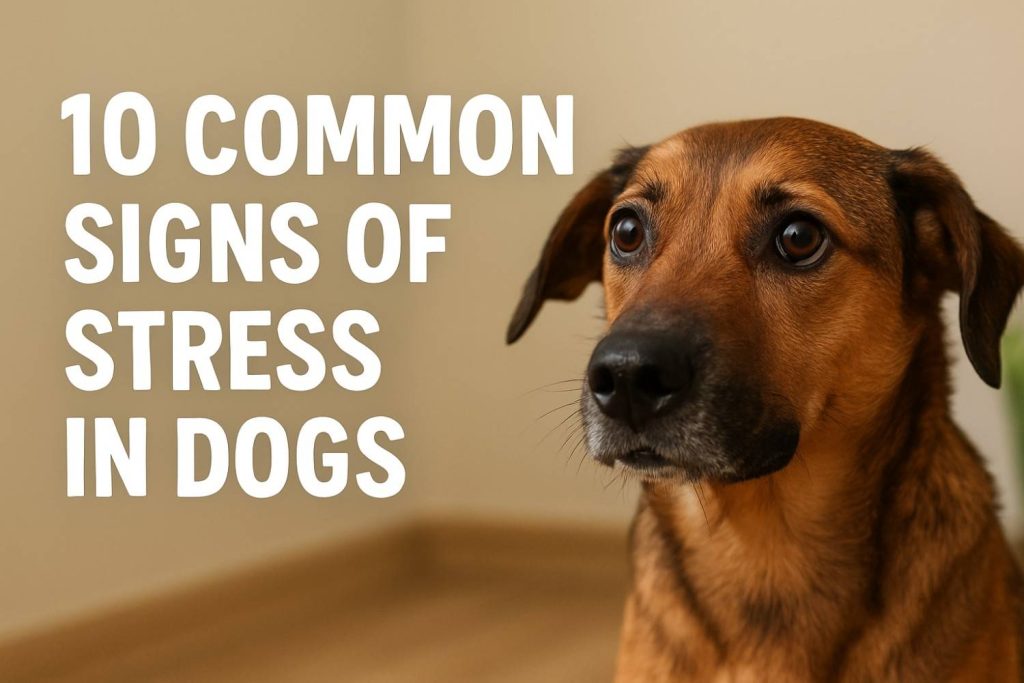As loving pet parents, we all want our furry companions to live happy, healthy, and stress-free lives. But just like humans, dogs experience stress too — and sometimes the signs are easy to miss. Understanding the symptoms of stress in dogs can help you take quick action to improve their well-being and prevent long-term health or behavioral issues.
In this guide, we’ll walk through 10 common signs of stress in dogs, what they mean, and practical tips to help your pup feel calm again.

Why Recognizing Stress in Dogs Matters
Stress in dogs isn’t just about behavior — it can also impact their physical health, immune system, digestion, and lifespan. When a dog is under constant stress, it may lead to:
-
Anxiety disorders
-
Aggressive behavior
-
Digestive problems
-
Weakened immune system
-
Decreased quality of life
By learning to spot the signs early, you can take steps to manage your dog’s stress naturally and improve their overall happiness.
1. Excessive Panting 😮💨
Panting is normal after exercise or in hot weather. But if your dog is panting heavily without obvious reasons, it could be a sign of stress or anxiety.
🔹 Dogs pant when they’re nervous, scared, or uncomfortable. For example, during thunderstorms, fireworks, or vet visits, you may notice fast, shallow panting.
Tip: Offer a quiet, safe space and calming techniques like a cool mat, soft music, or slow petting.
2. Pacing Back and Forth 🚶♂️🐾
A stressed dog often shows restless pacing — moving back and forth repeatedly without settling down.
This usually happens when dogs feel trapped in an uncomfortable situation, such as being left alone, hearing loud noises, or meeting strangers.
Tip: Identify the stress trigger and redirect your dog’s focus with toys, treats, or gentle training.
3. Shaking or Trembling 🌀
Dogs may shake off after a bath or nap, which is normal. But constant trembling or shivering without cold is often linked to fear or stress.
For example, many dogs tremble during car rides or vet visits.
Tip: Use positive reinforcement (treats, praise, cuddles) to build positive associations with stressful events.
4. Ears Pinned Back 👂
A dog’s ears say a lot about its emotional state. When ears are pulled back and flat against the head, it’s often a clear sign of fear, stress, or discomfort.
This signal may appear along with dilated pupils, tucked tail, or lowered body posture.
Tip: Give your dog space, speak softly, and avoid forcing interaction during these moments.
5. Changes in Appetite 🍗🚫
Stress can cause a dog to refuse food or eat less than usual. In some cases, anxious dogs may eat too quickly or chew objects they shouldn’t.
If your dog skips meals regularly, it’s time to rule out medical issues — but stress and anxiety are often big contributors.
Tip: Stick to a consistent feeding schedule, reduce stressful triggers, and offer nutritious calming treats.
6. Excessive Licking or Chewing 🐾
Some dogs cope with stress through repetitive licking or chewing, often on their paws, legs, or objects around the house.
This self-soothing behavior can lead to hot spots, skin infections, or hair loss if not managed.
Tip: Provide chew toys, interactive feeders, and plenty of mental stimulation to reduce stress-driven behaviors.
7. Tail Tucked Between Legs 🐕
A tucked tail is one of the most obvious signs of stress in dogs. It signals fear, submission, or discomfort.
You may notice this when your dog is around unfamiliar dogs, loud environments, or when scolded.
Tip: Avoid punishment — instead, reassure your dog with gentle tone, safe spaces, and positive reinforcement.
8. Excessive Barking or Whining
While barking is a normal form of communication, excessive barking or whining may mean your dog is feeling anxious or stressed.
Dogs may bark at unfamiliar sounds, strangers, or when left alone — all signs of underlying stress.
Tip: Use training, desensitization, and puzzle toys to keep your dog occupied and calm.
9. Aggression or Sudden Behavior Changes ⚡
Stress can trigger unexpected aggression in even the sweetest dogs. Snapping, growling, or biting may occur if your dog feels overwhelmed or unsafe.
This doesn’t mean your dog is “bad” — it means they’re struggling to cope.
Tip: Consult a professional trainer or vet to address stress-induced aggression safely.
10. Digestive Issues 💩
Just like humans, stressed dogs may develop upset stomachs, diarrhea, or constipation. Stress affects the gut-brain connection, leading to digestive imbalances.
If your dog suddenly develops stomach issues without dietary changes, stress may be the root cause.
Tip: Provide a calm eating environment, avoid sudden food changes, and consult your vet if symptoms persist.
How to Help a Stressed Dog
If you notice multiple stress signals, here are proven ways to calm your dog:
-
✅ Exercise daily – walks, play, or dog sports
-
✅ Mental enrichment – puzzle toys, sniff games, training
-
✅ Safe space – crate, quiet room, or cozy bed
-
✅ Soothing aids – calming music, pheromone diffusers, weighted blankets
-
✅ Routine & consistency – dogs thrive on predictability
-
✅ Vet checkup – to rule out medical issues
Final Thoughts
Recognizing the common signs of stress in dogs is the first step to supporting your furry friend. From panting and pacing to digestive issues and aggression, stress can show up in many ways.
By paying close attention to your dog’s body language and behavior, you can take proactive steps to reduce stress, build trust, and improve their quality of life.

